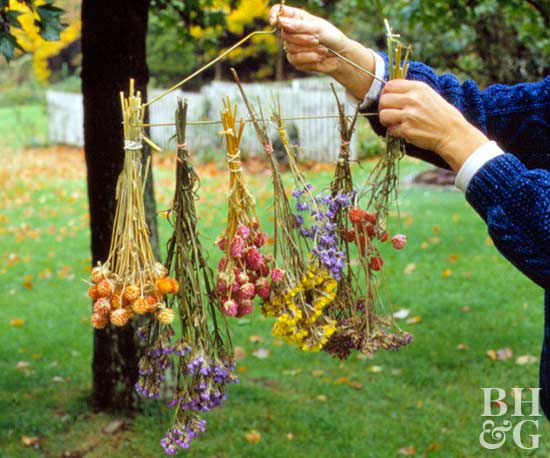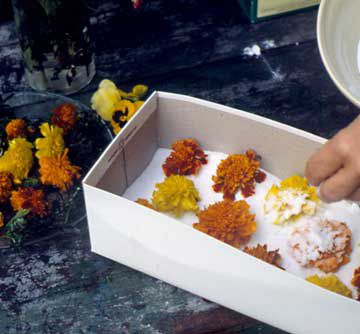Color Combinations
While the common name of strawflower doesn’t paint a pretty picture, you will understand the name once you feel the coarse, straw-like flowers. The showy petals of this plant aren’t even petals at all, but modified leaves called bracts. These bracts serve to protect the tender flower parts within until they are ready to open and be pollinated—hence their coarse texture and resilient nature. The showy blossoms can often be found in a variety of colors, most commonly warm tones of yellow, orange, and red and sometimes shimmering pink and white. The flowers are held above narrow, green foliage that is often covered in dense hairs. These hairs protect the plant from drying out, making strawflower a suitable plant for dry growing conditions.
Strawflower Care Must-Knows
If you are planning on growing strawflower plants from seed, it is best to start a little earlier than usual. Generally, the ideal time is 6-8 weeks before the final frost date in your area. At this point seedlings can be placed outdoors in well-drained soil. Hailing from tough areas in Australia, they can occasionally be found growing in very dry areas, sometimes even in pure sand. If they are planted in too fertile soil, plants can become overly lush and floppy. However, if planted in containers, plants will appreciate occasional fertilizer to help encourage continuous blooms. When it comes to watering, it is best to keep plants on the drier side as too much moisture will lead to rot.
For the best and brightest colors and the most floriferous display, be sure to plant in full sun. This will also help to prevent flopping and weak stems, which is important when growing cut flower varieties since these types can become quite large. Because the blossoms on strawflowers often look good even when fading, deadheading is not necessary but can help encourage a fresh set of blooms. If left on the plant in warmer climates, the flowers will help reseed and encourage a new generation of plants. If you are planning on cutting strawflowers to dry and use in arrangements, simply cut stems and hang upside down to air dry.
Annuals For Drying

Air-dry annuals in bunches upsidedown.
Many annuals are beautiful when dried. Among the best flowers for drying are hollyhock blossoms, zinnias, and cosmos dried in sand or silica gel (found at craft and hobby stores); love-lies-bleeding, prince’s-feather (Amaranthus hybridus var. erythrostachys), cockscomb, and plumed celosia hung upside down and air-dried; and snapdragons dried in silica gel. Most of the ornamental grasses, including hare’s-tail grass (Lagurus ovatus), quaking grass (Briza maxima and B. minor), foxtail millet (Setaria italica), and squirreltail grass (Hordeum jubatum) dry perfectly by hanging bunches upside down in a dry room, but they must be picked when fresh. Don’t forget the leaves of dusty-millers, which are elegant when pressed and dried.
Many annuals can be air-dried by gathering them in bunches and hanging them upside down in a well-ventilated place. Hanging them on a coat hanger works well.
Instructions:

Drying petaled flowers requires adifferent technique.
1. The classic way to dry flowers is to gather them in small bunches and hang them upside down in a dry, airy place out of direct sun. You might try suspending the flowers from coat hangers.
2. Many-petaled flowers such as zinnias and marigolds often dry best in a desiccant powder like silica gel. Lay the flower heads on a layer of desiccant, then sprinkle more powder over the flowers to cover.
Timesaving Tip: Some annuals will dry perfectly when simply stuck in a bottle. Flowers to dry this way include starflower, statice, globe amaranth, and love-in-a-mist.
More Ways to Dry Annuals
On Wires
Flowers that feel dry and papery are very easy to preserve. The strawflower, for example, has petallike bracts that are firm and brittle. To dry, simply clip the bloom from the plant just beneath the head (the stem doesn’t dry well). Select flowers that are just beginning to open. Right after picking, insert a 20-gauge wire through the stem end of the flower head; stick the other end of the wire into a foam board. Let dry for 3 weeks.
Upside Down
Another flower that’s easy to air-dry is the globe amaranth. Cut the stems when the flowers are just starting to show color and hang them upside down in a dry area for about 3 weeks. Dry baby’s breath, fernleaf yarrow, silver-leaved artemisia, liatris, ammobium, statice, celosia, ‘Victoria Blue’ salvia, hydrangea, and long-stemmed roses in a similar way. These flowers will dry best if you also follow these tips:
- Cut stems at bouquet length
- Cut flowers in mid-morning
- Pick flowers at their peak
- Put them in a vase of cool water if you can’t hang them to dry right away
In Silica Gel
Some flowers, such as dahlias, zinnias, feverfew, delphiniums, snapdragons, and daisies, dry best in silica gel (found at craft and hobby stores). Place flower heads face up on a 1-inch bed of silica gel crystals in an airtight container. Also, gently shake crystals over flowers, covering completely. Seal container. Leave for two days to one week, checking often to avoid overdrying (flowers will become brittle).